The NASA Electronic Parts and Packaging (NEPP) '02 Workshop
The NASA Electronic Parts and Packaging (NEPP) '02 Workshop
The NASA Electronic Parts and Packaging (NEPP) '02 Workshop
Create successful ePaper yourself
Turn your PDF publications into a flip-book with our unique Google optimized e-Paper software.
Abstracts ________________________<br />
presentation will describe some of the reliability tests, results, <strong>and</strong><br />
on-going work on MEMS devices at our facility.<br />
Speaker Biography<br />
Jeffery C. Gannon is the Accelerometer Business <strong>and</strong> Technology<br />
Development Manager for Applied MEMS, Inc. He entered the<br />
MEMS field in 1994 <strong>and</strong> has been instrumental in developing the<br />
high performance MEMS digital accelerometer system for his<br />
parent company Input/Output, Inc. From 1968 thru 1994 he held<br />
various technical, engineering, engineering physics, <strong>and</strong><br />
management positions at Fermi National Accelerator Laboratory in<br />
Illinois <strong>and</strong> the Super Conducting Supercollider Laboratory in<br />
Texas. Mr. Gannon has been awarded three patents, has several<br />
pending, <strong>and</strong> has published 30 papers <strong>and</strong> technical articles. He is<br />
a co-recipient of an R&D 100 award for his work on the liquid<br />
helium refrigeration system for the Tevatron Superconducting<br />
Particle Accelerator at Fermilab. Mr. Gannon graduated from<br />
DeVry Institute of Technology in 1968.<br />
Chris Behrens is a Sr. Staff Engineer at Applied MEMS, Inc. She is<br />
responsible for the Analytical Services Group, which includes<br />
reliability, failure analysis <strong>and</strong> QA. For the past 2 years, she has<br />
been involved in the MEMS field. Prior to that, she worked as a<br />
materials engineer specializing in marine seismic equipment. She<br />
holds degrees in chemistry from Wayne State University <strong>and</strong><br />
UCLA.<br />
Reliable, Laser-welded <strong>Packaging</strong> of a Nd:YAG Laser for<br />
Spaceflight Application<br />
Cheryl G. Asbury, Jerry L. Mulder, Duncan Liu, Serge Dubovitsky<br />
Jet Propulsion Laboratory, California Institute of Technology<br />
4800 Oak Grove Dr. m/s 198-235, Pasadena, CA,<br />
91109, USA, 818-393-6620 e-mail:<br />
Cheryl.G.Asbury@jpl.nasa.gov<br />
Abstract<br />
<strong>The</strong> success of interferometry in space depends on the<br />
development of lasers that can survive launch conditions <strong>and</strong> the<br />
space environment during missions that could last five years or<br />
more. This paper describes the fabrication of a rugged, laserwelded<br />
package for a 200mW, monolithic diode-pumped solid-state<br />
Nd:YAG laser operating at 1319nm. Environmental testing shows<br />
that the laser withst<strong>and</strong>s non-operational thermal cycles over a<br />
temperature range from –20 to 55 degrees Celsius, <strong>and</strong> 22.3 g-rms<br />
of r<strong>and</strong>om vibration, with little or no degradation of laser output<br />
power or performance. <strong>The</strong> novel packaging method employs a<br />
specially designed housing to which multi-mode or single-mode<br />
polarization-maintaining fiber pigtails can be aligned <strong>and</strong> laserwelded<br />
into place. To further enhance reliability, a redundant<br />
pumping system called the Multi-Fiber Pump Ferrule (MFPF) was<br />
developed <strong>and</strong> implemented. <strong>The</strong> MFPF allows multiple laser diode<br />
pump modules to be aligned to the laser crystal simultaneously, in<br />
order to accommodate either parallel or st<strong>and</strong>by pump redundancy.<br />
This compact, lightweight design is well suited for space flight<br />
applications <strong>and</strong> the laser-welded technique can easily be adapted<br />
to many other fiber optic <strong>and</strong> electro-optic devices in which critical<br />
optical alignments must be maintained in a harsh environment.<br />
Key Words: Laser, <strong>Packaging</strong>, Laser-welded, Fiber-pigtail<br />
Speaker Biography<br />
Cheryl Asbury earned her Bachelor’s degree in Applied <strong>and</strong><br />
Engineering Physics from Cornell University <strong>and</strong> her Master’s<br />
degree in Applied Physics from the University of Michigan. Before<br />
31<br />
joining JPL, she led a team at Lightwave <strong>Electronic</strong>s Corporation<br />
that space-qualified one of their commercial diode-pumped solidstate<br />
laser products.<br />
Reliability of CSP Assemblies with Underfill Subjected to 4,000<br />
Extreme Temperature Cycles<br />
Reza Ghaffarian, Ph.D.<br />
Jet Propulsion Laboratory<br />
California Institute of Technology<br />
Pasadena, California<br />
818-354-2059, Reza.Ghaffarian@jpl.nasa.gov<br />
Abstract<br />
<strong>The</strong> MicrotypeBGA Consortium led by the Jet Propulsion<br />
Laboratory pooled its members' resources to develop the quality<br />
<strong>and</strong> reliability of chip scale packages for a variety of projects. In the<br />
process of building the consortium's chip scale package (CSP) test<br />
vehicles, many challenges were identified regarding various<br />
aspects of technology implementation. CSPs were assembled on<br />
single- <strong>and</strong> double-sided printed circuit board (PCB) with <strong>and</strong><br />
without underfill. <strong>The</strong> test vehicles were subjected to various<br />
environmental tests including four thermal cycling considerations.<br />
<strong>The</strong>se cycles represent the extreme harsh accelerated testing in<br />
the range of 55°C to +125°C to a commercial requirement in the<br />
range of 0°C to 100°C. <strong>The</strong>rmal cycling test results to 2,000 cycles<br />
performed under different environmental conditions for single- <strong>and</strong><br />
double-sided assemblies with <strong>and</strong> without underfill were presented<br />
previously.<br />
Majority of CSPs failed to 2,000 cycles, even a few with underfill.<br />
However, a few CSP configurations did not failed to 2,000 cycles in<br />
the range of - 30 to 100°C. <strong>The</strong>se assemblies were further thermal<br />
cycled to establish their long-life failure behavior. A few robust<br />
assemblies did not failed to 3,000 cycles in this temperature<br />
regime. Increasing the temperature regime to a much higher level,<br />
i.e., -55/125°C, accelerated the failures. Additional failures to 887<br />
cycles in this temperature regime were observed. A few that<br />
remained intact were cycled in a significantly larger temperature<br />
swing representative of Mars environment (-120 to 115°C).<br />
Reliability test results to near 4,000 cycles with X-ray <strong>and</strong> optical<br />
inspection performed at various cycles are presented.<br />
Speaker Biography<br />
Dr. Reza Ghaffarian has 20 years of industrial <strong>and</strong> academic<br />
experience in mechanical, materials, <strong>and</strong> manufacturing process<br />
engineering. At JPL, Quality Assurance Section, he supports<br />
research <strong>and</strong> development activities in SMT, BGA, CSP, <strong>and</strong><br />
MEMS/MOEMS technologies for infusion into <strong>NASA</strong>’s missions. He<br />
was the recipient of <strong>NASA</strong> Exception Service Medal for outst<strong>and</strong>ing<br />
leadership, industrial partnering, <strong>and</strong> expertise in failure modes <strong>and</strong><br />
effects analysis <strong>and</strong> environmental testing of electronic packaging<br />
technologies. He has authored more than 100 technical papers, coeditor<br />
of a CSP book, 3 book chapters, two guidelines, <strong>and</strong><br />
numerous patentable innovations. He serves as technical<br />
advisor/Committee to Chip Scale Review Magazine,<br />
Microelectronics Journal, SMTA, IMAPS, <strong>and</strong> IPC. He is a frequent<br />
speaker <strong>and</strong> chaired technical conferences including SMTA<br />
International, IMAPS, ASME, SAMPE, NEPCON, SEMI, IEEE<br />
CPMT, <strong>and</strong> IPC. He received his M.S. in 1979, Engineering Degree<br />
in 1980, <strong>and</strong> Ph.D. in 1982 in engineering from University of<br />
California at Los Angeles (UCLA).



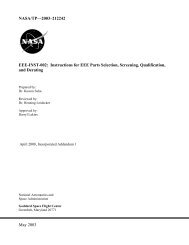

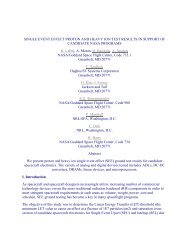
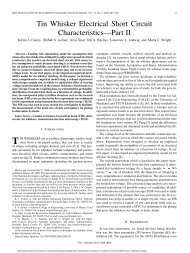
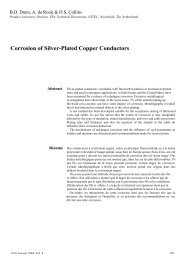
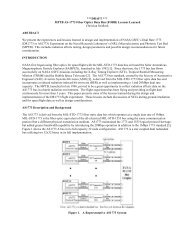

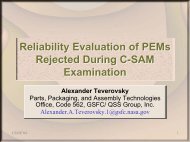
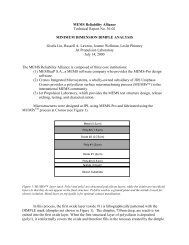
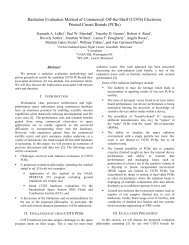
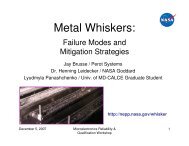
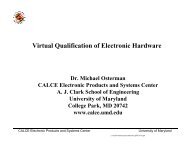
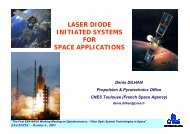
![mil-std-2223 [test methods for insulated electric wire] - NEPP](https://img.yumpu.com/4036001/1/190x249/mil-std-2223-test-methods-for-insulated-electric-wire-nepp.jpg?quality=85)